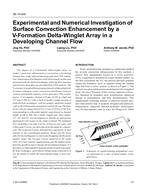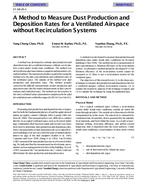A Wall Energy Rating (WER) system has been proposed to account for simultaneous thermal conduction and air leakage heat losses through a full-scale wall system. Determining the overall WER requires that two standard tests be performed on a full-scale wall specimen: a thermal resistance test and an air leakage test. A three-dimensional model representation of the wall
specimen is developed to combine the results of these tests to obtain an accurate prediction of the wall thermal resistance (apparent R-value) under the influence of air leakage. Two types of wall configurations were simulated. The first one was a standard 2 in. by 6 in. wood stud frame construction, made of spruce, spaced at 16 in. (406 mm) o/c in 2.4 m × 2.4 m full-scale wall specimens.
The second type of wall configuration was similar to the first one except that it included through-wall penetrations (a window opening, a pipe, an electric box, and a duct), according to the Canadian Construction Material Centre (CCMC) Air Barrier Guide 07272 (1996). The cavities of the two types of wall configurations were filled with different types of insulations (i.e., Open Cell Spray Polyurethane foams). Results showed that the present model predicted the R-values of all walls to within +5%. After gaining confidence in the model predictions, it was used to determine the apparent R-values for these walls at different air leakage rates.
Citation: Thermal Performance, International Conference, 2010
Product Details
- Published:
- 2010
- File Size:
- 1 file , 3.4 MB
- Product Code(s):
- D-BuildingsXI-21


